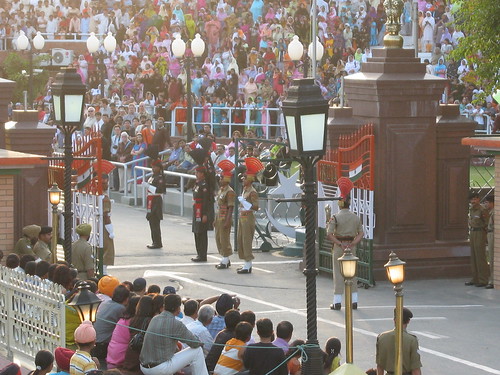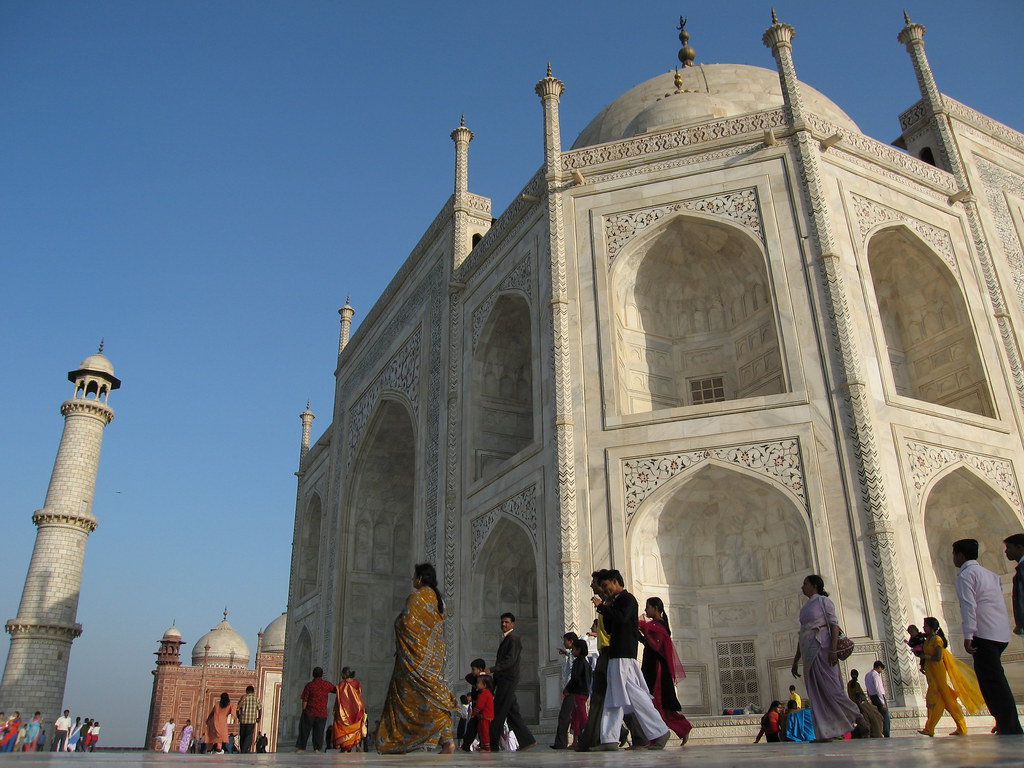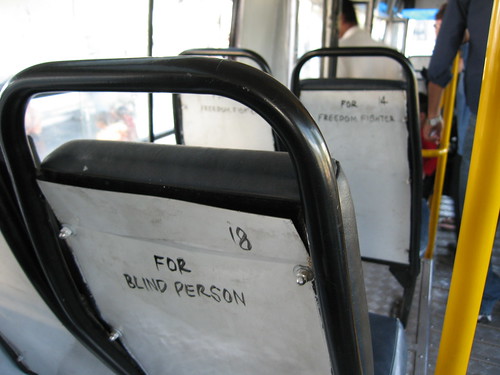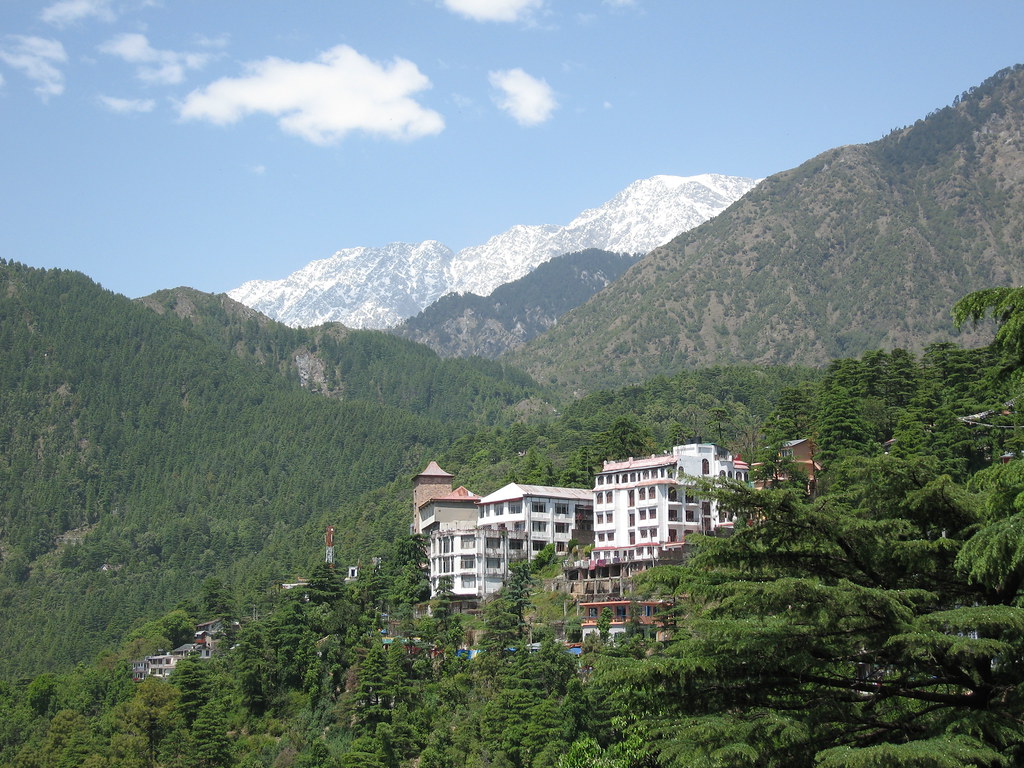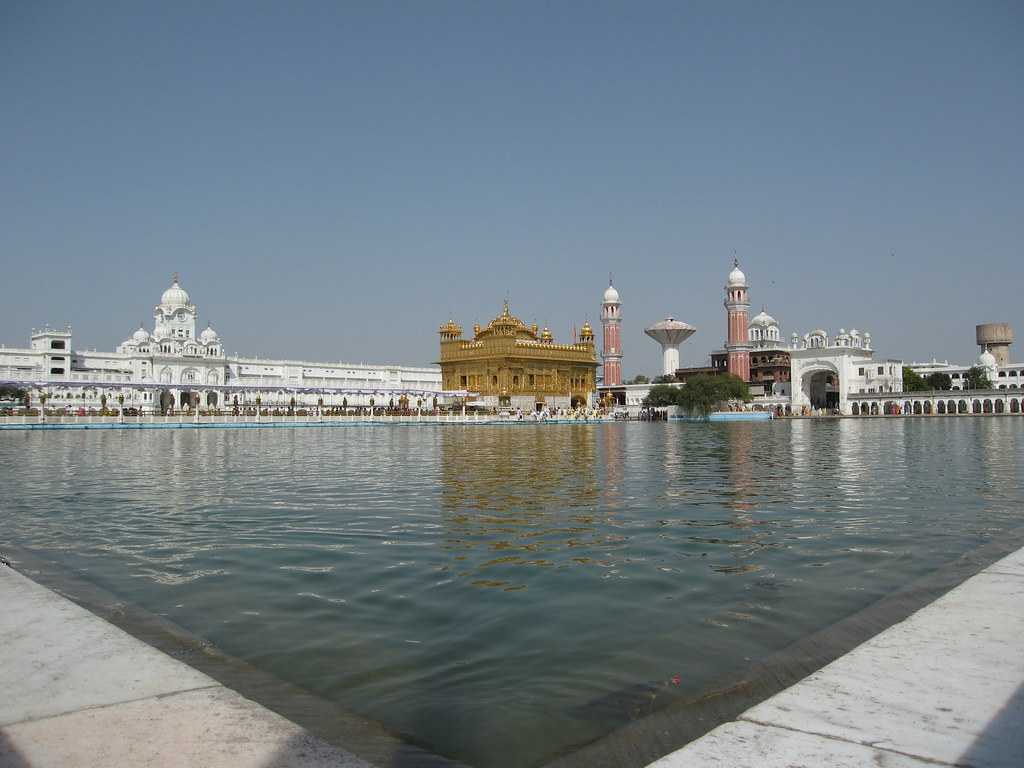Pakistan
The Indian-Pakistani border is one of the strangest borders we've been across. There is no visible trade or movement of people between Pakistan and India so there is only a trickle of pedestrian traffic at the best of times. In the evenings thousands of Indians and Pakistanis travel to their respective sides of the border for the "closing of the border ceremony" to cheer on their 6ft 5" + border guards. They've even built grandstands to house the crowd. It's a pantomime of an affair evoking national pride on both sides. After 20 minutes of posturing, marching, throwing dirty looks at each other, high kick marching and violently throwing their gate open and slamming them closed both flags are inched down the flagpoles - one cannot be higher than the other as it suggests superiority. From the Indian border it's only about 25 minutes to Lahore but it's definitely worlds apart.

Having the same roots as India we expected Pakistan to be very similar, but were surprised by the number contrasts. Lahore is a modern city with big wide streets and traffic lights (that are obeyed). When we left India it seems like we left the crowded, disorganised hecticness and organised chaos of everyday life behind. In Amritsar our diet was totally vegetarian. 50 km away, Lahore is a vegetarian's nightmare, meat meat meat is all that can be got - and as a Muslim nation the cow is no longer sacred.
Lahore has received a lot of attention in the Western media this year so I'm sure our family and friends reading this will have a distorted impression of what the city is like. One of the first things we noticed was a heavy riot police presence outside of the city mosques. Around the corner from our guesthouse was a building that was bombed a couple of months ago - apparently it was the highest intensity blast and all the windows in the hostel were blown out. A couple of evenings as we sat talking to other travellers we heard what could be gunshots ... We noticed all of these things; coming to Lahore aware and trying to avoid danger. In reality when you talk to locals in Lahore you find out that the bombings were targeted on government buildings, the police presence is normal and there for every one's protection, the "gunshots" are more than likely fireworks for a wedding celebration and you are as safe in Lahore as any other city in the world. Recent political events have taken their toll however. The judges have yet to be reinstated and people are anxious for promised change. Ordinary life for the people has been affected by an increase in food prices and there are multiple powercuts daily as the electricity grid struggles to meet the needs of the people.
As a Muslim nation the Pakistan people are among the most welcoming in the world. We didn't come across any aggressive touts, even the autorickshaw drivers are courteous. It's impossible to walk around Lahore without getting adopted by a local who ensures you're going the right way. A couple of times people paid our bus fare as a token of their hospitality. In essence it's a society of honesty where you can stop being paranoid that everyone is trying to take you to the cleaners and make a rupee out of you.
Visually Lahore is a city dominated by mosques and populated by men in Salwar Kameez and women wearing hajibs and chandors. Females travelling to the country are expected to respect the Muslim hajib rules which really equates to wearing a long sleeved top that amply covers your bum and a headscarf. As opposed to other Muslim countries the women dress very colourfully seeing women dressed completely in black is an exception.
Our week in Lahore was spent at the Regal Inn Guesthouse - an infamous guesthouse that attracts most of the backpackers passing through. It's location on the crossroads between Asia and Middle East means that it has evolved into the unofficial centre of the latest information from travellers coming from either direction. We arrived on Thursday which is renowned as being music night. Malik - the owner of the guesthouse organises his guests to attend a local shrine where sufi music is being played. Without going into lots of detail, it was a wild introduction to Pakistan. Throngs of men jammed together in the dark smoking charras and shaking their heads to the mesmerising drumming of the Gongasain Brothers (one of whom is deaf) which started around 10pm and continued until very late. Very full on.
The number of travellers in the region at the moment has dropped off due to security fears - so it's only the most brave or hardy coming through at the present time. Naturally this leads to a rather unusual bunch of people - some whose next port of call was Afghanistan. The mix was broadly Canadian, Japan, Chinese, Moroccan, Korean, Spanish and French. Most people were hanging around in 45 degree heat waiting for visas or resting before heading on the road again. The result was a group of people sitting around hotly discussing issues like the Chinese girls attitude to Tibet, what the Japanese guy thought about whaling, the small matter of the "Rock" between Morocco and Spain etc. Suffice to say it was real "don't mention the war" material.
When we did escape from the hostel it was out to get fantastic icecreams, strawberry milkshakes and cold coffee shakes from Chaman across the road. We found Food Street, an atmospheric open air eating street a few kilometres away and tried out some great Pakistani dishes. Reminiscent of Vietnam we hit the tailors to get some hajib friendly clothes made for Iran. The rest of our time was spend to-ing and fro-ing to the Iranian embassy to get our visas. Once we got them it was off to the station to get a train ticket towards to Iranian border.
Getting our train ticket was a total fiasco, we were informed that we were entitled to a substantial discount so we headed off in search of the "Commercial Office" of Pakistan Railways only to be redirected to another outlying office. Eventually we found the right team of people who could rubberstamp a concession form and send us on our way. His office was at the back of a vast complex of rooms full of men sitting around looking at folders covered in dust. I don't think any work had been done by anyone in years. It was bureaucracy at it's best. Duplicate copies of everything, everything stamped and placed in a folder not a telephone in sight. We walked past tables of open folders with the date 2004 on them. After 30 minutes of hanging around discussing Imran Khan's appeal and Ricky Ponting's captaincy we were on our way with our all important concession form - an aged delicate piece of paper, parchment colour with letters uneven from typewriter production. We took our concession to the ticket office and were told that it was worthless and couldn't be used on the train we wanted. Problem is we don't think that anyone has communicated this to the guys back in the dusty office. So hours wasted .... but not as many hours as the guys in the Pakistani Train Office are wasting day in day out.
Armed with a half dozen boiled eggs, a loaf of bread and jar of strawberry jam we boarded the train from Lahore to Quetta. The train journey takes 24 hours from point to point, then turns around and does the journey back. The train left 2 hours late, which essentially means it's eternally late, it can never make up the time. We shared our business class aircon berth with four Pakistani business men. One of them a car smuggler involved in what he termed "risky business". The train was surprising;y comfortable and we arrived the following afternoon in Quetta dustfree. Just before we arrived one of the guys bought a newspaper and announced that the border between Pakistan and Iran at Taftan had been closed for "security reasons". This was the worst news we could have got as we were stuck in limbo and had no choice but to proceed onwards and hope that the border would have reopened by the time we reached it.
Quetta is a frontier town with a diverse mix of people, Afghanis, Taliban, Nomads, outlaws etc. We'd heard mixed reports about Quetta. One girl we'd met told us people had thrown stones at her there, another guy had said it was one gun shop after another and it didn't exactly entice you to stick around. We didn't see anything out of the ordinary there - mind you it was a fleeting trip before we headed off on a night bus to the Iranian border town of Taftan.
This was the section of the journey we were looking forward to the least. The stretch of land between Quetta and Taftan - the heart of Balochistan - is open desert that skirts the Afghani border. If there's anywhere you're going to be ambushed it's along this road in the dead of night. The route is a busy one so there is relative safety in numbers. We did make a special effort to keep the curtains closed so as not to be a target if someone decided to take a pop at the bus - I think that was just the imagination playing up! Being the only foreigners on the bus we had to get off at regular police checkpoints so they could take our names and passport numbers. Luckily we'd a smooth journey, our only complaint being the drivers inability to fix the air conditioning at a comfortable temperature. Our journey to Taftan ended at 6am when we were unceremoniously dumped out in Taftan at the door of a restaurant open and waiting to relieve everyone of the last of their Pakistani Rupees. After a quick cup of tea we walked the last kilometre to border and waited for it open.
Read Full Post...

:: Indian Border Guard (Giant ) ::
We spent a week in Lahore waiting for our Iranian visa to come through and thoroughly enjoyed every minute of it. Pakistan was created as a country in 1947 after the British partitioned the north of India into Hindu and Muslim states. This action resulted in a massive movement of Hindus south into India and Muslims north into Pakistan - with lots of blood spilt along the way.Having the same roots as India we expected Pakistan to be very similar, but were surprised by the number contrasts. Lahore is a modern city with big wide streets and traffic lights (that are obeyed). When we left India it seems like we left the crowded, disorganised hecticness and organised chaos of everyday life behind. In Amritsar our diet was totally vegetarian. 50 km away, Lahore is a vegetarian's nightmare, meat meat meat is all that can be got - and as a Muslim nation the cow is no longer sacred.
Lahore has received a lot of attention in the Western media this year so I'm sure our family and friends reading this will have a distorted impression of what the city is like. One of the first things we noticed was a heavy riot police presence outside of the city mosques. Around the corner from our guesthouse was a building that was bombed a couple of months ago - apparently it was the highest intensity blast and all the windows in the hostel were blown out. A couple of evenings as we sat talking to other travellers we heard what could be gunshots ... We noticed all of these things; coming to Lahore aware and trying to avoid danger. In reality when you talk to locals in Lahore you find out that the bombings were targeted on government buildings, the police presence is normal and there for every one's protection, the "gunshots" are more than likely fireworks for a wedding celebration and you are as safe in Lahore as any other city in the world. Recent political events have taken their toll however. The judges have yet to be reinstated and people are anxious for promised change. Ordinary life for the people has been affected by an increase in food prices and there are multiple powercuts daily as the electricity grid struggles to meet the needs of the people.
As a Muslim nation the Pakistan people are among the most welcoming in the world. We didn't come across any aggressive touts, even the autorickshaw drivers are courteous. It's impossible to walk around Lahore without getting adopted by a local who ensures you're going the right way. A couple of times people paid our bus fare as a token of their hospitality. In essence it's a society of honesty where you can stop being paranoid that everyone is trying to take you to the cleaners and make a rupee out of you.
Visually Lahore is a city dominated by mosques and populated by men in Salwar Kameez and women wearing hajibs and chandors. Females travelling to the country are expected to respect the Muslim hajib rules which really equates to wearing a long sleeved top that amply covers your bum and a headscarf. As opposed to other Muslim countries the women dress very colourfully seeing women dressed completely in black is an exception.
Our week in Lahore was spent at the Regal Inn Guesthouse - an infamous guesthouse that attracts most of the backpackers passing through. It's location on the crossroads between Asia and Middle East means that it has evolved into the unofficial centre of the latest information from travellers coming from either direction. We arrived on Thursday which is renowned as being music night. Malik - the owner of the guesthouse organises his guests to attend a local shrine where sufi music is being played. Without going into lots of detail, it was a wild introduction to Pakistan. Throngs of men jammed together in the dark smoking charras and shaking their heads to the mesmerising drumming of the Gongasain Brothers (one of whom is deaf) which started around 10pm and continued until very late. Very full on.
The number of travellers in the region at the moment has dropped off due to security fears - so it's only the most brave or hardy coming through at the present time. Naturally this leads to a rather unusual bunch of people - some whose next port of call was Afghanistan. The mix was broadly Canadian, Japan, Chinese, Moroccan, Korean, Spanish and French. Most people were hanging around in 45 degree heat waiting for visas or resting before heading on the road again. The result was a group of people sitting around hotly discussing issues like the Chinese girls attitude to Tibet, what the Japanese guy thought about whaling, the small matter of the "Rock" between Morocco and Spain etc. Suffice to say it was real "don't mention the war" material.
When we did escape from the hostel it was out to get fantastic icecreams, strawberry milkshakes and cold coffee shakes from Chaman across the road. We found Food Street, an atmospheric open air eating street a few kilometres away and tried out some great Pakistani dishes. Reminiscent of Vietnam we hit the tailors to get some hajib friendly clothes made for Iran. The rest of our time was spend to-ing and fro-ing to the Iranian embassy to get our visas. Once we got them it was off to the station to get a train ticket towards to Iranian border.
Getting our train ticket was a total fiasco, we were informed that we were entitled to a substantial discount so we headed off in search of the "Commercial Office" of Pakistan Railways only to be redirected to another outlying office. Eventually we found the right team of people who could rubberstamp a concession form and send us on our way. His office was at the back of a vast complex of rooms full of men sitting around looking at folders covered in dust. I don't think any work had been done by anyone in years. It was bureaucracy at it's best. Duplicate copies of everything, everything stamped and placed in a folder not a telephone in sight. We walked past tables of open folders with the date 2004 on them. After 30 minutes of hanging around discussing Imran Khan's appeal and Ricky Ponting's captaincy we were on our way with our all important concession form - an aged delicate piece of paper, parchment colour with letters uneven from typewriter production. We took our concession to the ticket office and were told that it was worthless and couldn't be used on the train we wanted. Problem is we don't think that anyone has communicated this to the guys back in the dusty office. So hours wasted .... but not as many hours as the guys in the Pakistani Train Office are wasting day in day out.
Armed with a half dozen boiled eggs, a loaf of bread and jar of strawberry jam we boarded the train from Lahore to Quetta. The train journey takes 24 hours from point to point, then turns around and does the journey back. The train left 2 hours late, which essentially means it's eternally late, it can never make up the time. We shared our business class aircon berth with four Pakistani business men. One of them a car smuggler involved in what he termed "risky business". The train was surprising;y comfortable and we arrived the following afternoon in Quetta dustfree. Just before we arrived one of the guys bought a newspaper and announced that the border between Pakistan and Iran at Taftan had been closed for "security reasons". This was the worst news we could have got as we were stuck in limbo and had no choice but to proceed onwards and hope that the border would have reopened by the time we reached it.
Quetta is a frontier town with a diverse mix of people, Afghanis, Taliban, Nomads, outlaws etc. We'd heard mixed reports about Quetta. One girl we'd met told us people had thrown stones at her there, another guy had said it was one gun shop after another and it didn't exactly entice you to stick around. We didn't see anything out of the ordinary there - mind you it was a fleeting trip before we headed off on a night bus to the Iranian border town of Taftan.
This was the section of the journey we were looking forward to the least. The stretch of land between Quetta and Taftan - the heart of Balochistan - is open desert that skirts the Afghani border. If there's anywhere you're going to be ambushed it's along this road in the dead of night. The route is a busy one so there is relative safety in numbers. We did make a special effort to keep the curtains closed so as not to be a target if someone decided to take a pop at the bus - I think that was just the imagination playing up! Being the only foreigners on the bus we had to get off at regular police checkpoints so they could take our names and passport numbers. Luckily we'd a smooth journey, our only complaint being the drivers inability to fix the air conditioning at a comfortable temperature. Our journey to Taftan ended at 6am when we were unceremoniously dumped out in Taftan at the door of a restaurant open and waiting to relieve everyone of the last of their Pakistani Rupees. After a quick cup of tea we walked the last kilometre to border and waited for it open.


